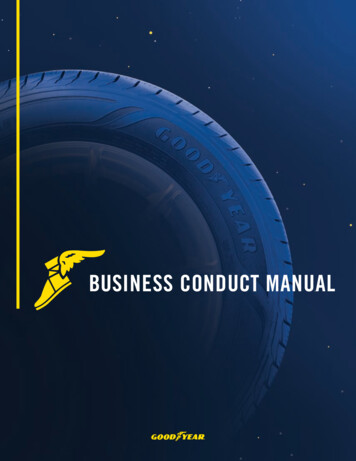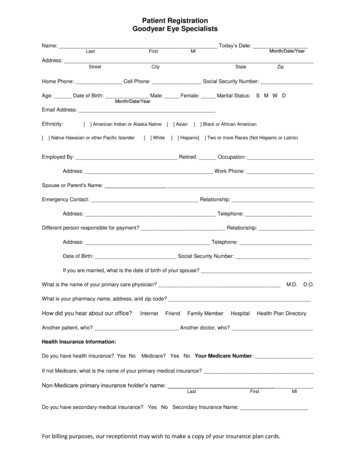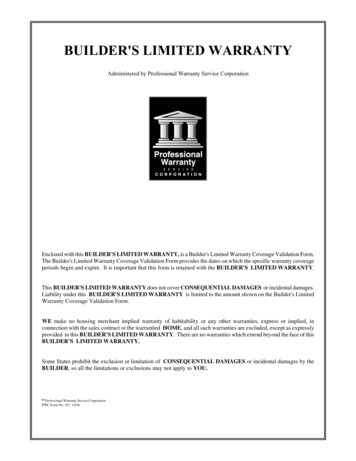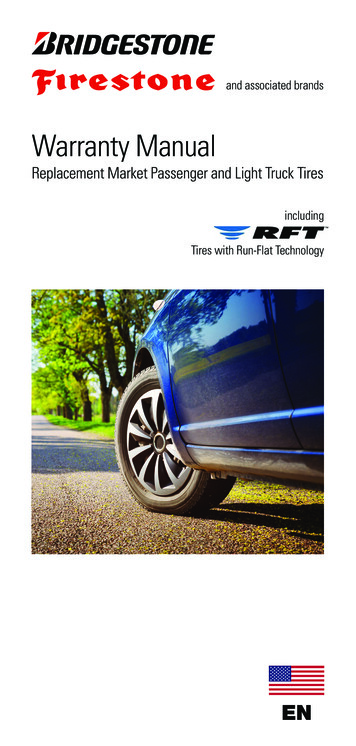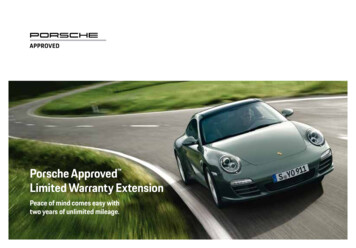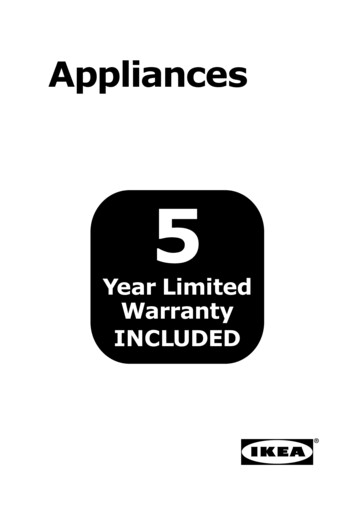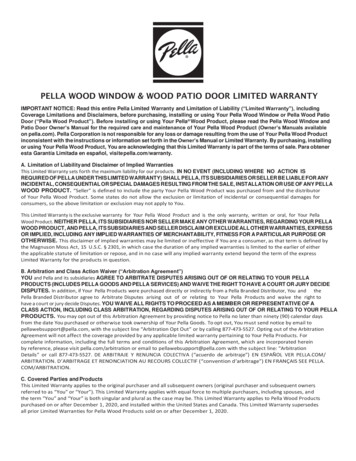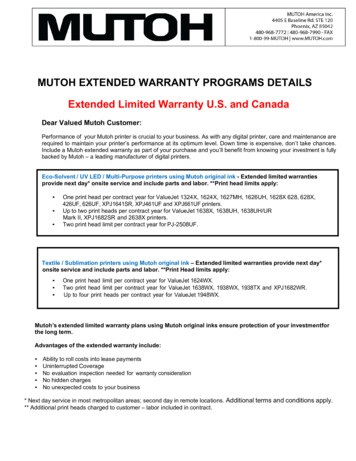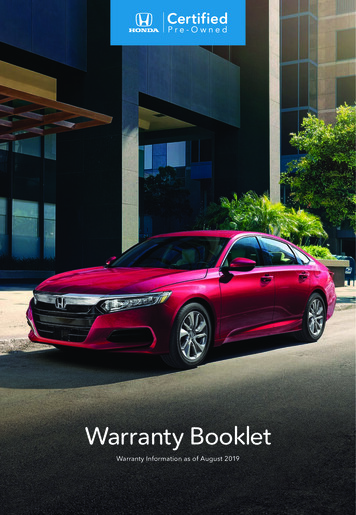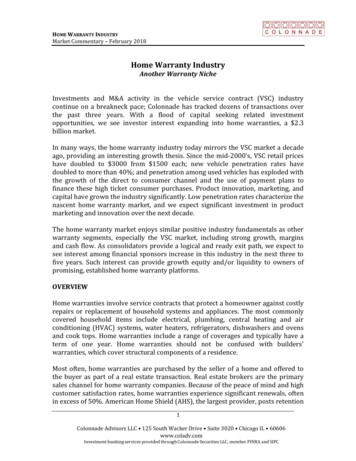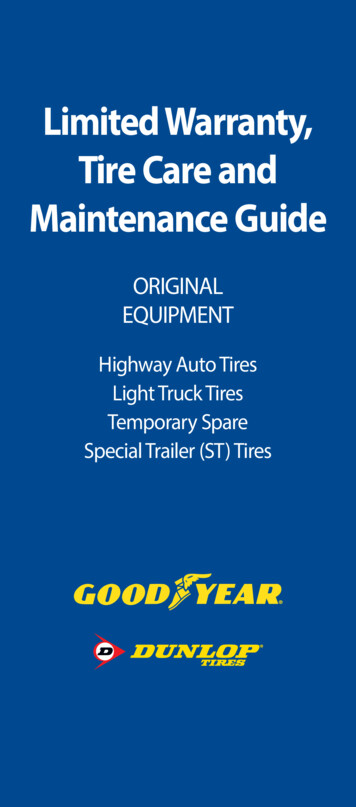
Transcription
Limited Warranty,Tire Care andMaintenance GuideORIGINALEQUIPMENTHighway Auto TiresLight Truck TiresTemporary SpareSpecial Trailer (ST) Tires
HIGHWAY AUTO, LIGHT TRUCK AND SPECIAL TRAILERTIRE WARRANTY AND ADJUSTMENT POLICY (EXCLUDESGOODYEAR UNISTEEL RADIAL LIGHT TRUCK TIRES)WHO IS ELIGIBLE?You are eligible for the benefits of this Limited Warranty if you meet allthe following criteria: You are the owner or authorized agent of the owner of new Goodyearor Dunlop highway auto or light truck tires or Goodyear SpecialTrailer (ST) tires supplied as Original Equipment on your vehicle ortrailer. Your tires bear Department of Transportation prescribed tireidentification numbers. Your tires have been used only on the vehicle on which they wereoriginally installed according to the vehicle manufacturer’s orGoodyear’s recommendations. Your tires were purchased on or after November 1, 2018.Light truck tires are defined as all tires identified with the “LT”designation in the sidewall stamping. e.g. LT245/75R16.Special Trailer tires are defined as all tires identified with the “ST”designation in the sidewall stamping, e.g. ST235/80R16.WHAT IS COVERED AND FOR HOW LONG?FREE TIRE REPLACEMENTAny new Goodyear or Dunlop highway radial auto, radial light truck tireor Goodyear Special Trailer (ST) tire, covered by this policy, removedfrom service due to a covered warranty condition during the first 2/32"of usable tread or twelve months from date of purchase, whichevercomes first, will be replaced with a comparable new Goodyear orDunlop tire at no charge, including mounting and balancing. (Withoutproof of purchase the date of manufacture will be used to determineeligibility.)ALL OTHER HIGHWAY AUTO OR LIGHT TRUCK TIRESAny new Goodyear or Dunlop highway auto or light truck tire, otherthan radial auto or radial light truck tires, removed from service dueto a covered warranty condition during the first 1/32" of usable treadwill be replaced with a comparable new Goodyear or Dunlop tire at nocharge, including mounting and balancing.TEMPORARY SPARE TIRESAny Goodyear or Dunlop temporary spare tire removed from service dueto a covered warranty condition during the first 50% of usable treadwear(1/32") will be replaced with a comparable new Goodyear or Dunloptemporary spare tire at no charge, including mounting.PRORATED ADJUSTMENTTires not eligible for free replacement that are removed fromservice due to a covered warranty condition will be replaced with acomparable new Goodyear or Dunlop tire on a prorated basis for upto six (6) years from the date of original new tire purchase or when thetreadwear indicators become visible (worn to 2/32"), whichever occursfirst. (Without proof of purchase the date of manufacture will be usedto determine eligibility.)HOW WILL PRORATED CHARGES BE CALCULATED?Replacement price will be calculated by multiplying the tire’sadvertised retail selling price at the time of adjustment by the
percentage of usable original tread that has been worn off. You payfor mounting and balancing, and an amount equal to the currentFederal Excise Tax (F.E.T. – U.S. only) and any other applicable taxes andgovernment-mandated charges.EXAMPLE: If your disabled tire had an original 8/32" of usabletreadwear and is worn to 4/32" usable tread remaining, you have used50% and therefore must pay 50% of the advertised retail selling priceof the comparable tire.In addition, you must pay an amount equal to the full current FederalExcise Tax (U.S. only) or any other applicable taxes and governmentmandated charges for the comparable new replacement tire at thetime of adjustment. If the price of the new comparable tire is 130.00,the cost to you would be 65.00 plus F.E.T. (U.S. only) plus any otherapplicable taxes and government-mandated charges.WHAT IS A COMPARABLE TIRE?A “comparable” new Goodyear or Dunlop tire will be the same brandtire and may be either the same line of tire or, in the event that the tireis not available, the same brand tire with the same basic constructionand similar performance attributes with a different sidewall or treadconfiguration. If a higher priced tire is accepted as replacement,the difference in price will be at an additional charge to you. Anyreplacement tire provided pursuant to this warranty will be covered bythe warranty in effect at the time of replacement.ADDITIONAL PROVISIONSA tire has delivered its full original tread life and the coverage of thislimited warranty ends when the treadwear indicators become visible(worn to 2/32") or six (6) years from the date of new tire purchase,whichever occurs first. (Without proof of purchase the date ofmanufacture will be used to determine eligibility.)LIMITATIONSThis limited warranty is applicable only in the United States and Canada.WHAT IS NOT COVERED BY THIS WARRANTY?This limited warranty does not cover the following: Tires submitted for ride disturbance complaints that are wornbeyond the first two thirty-seconds of an inch (2/32") tread depth ortires submitted for ride disturbance due to damaged wheels or anyvehicle condition. Goodyear does not warrant or give credit in any adjustmenttransaction for any kind of material added to a tire (e.g., tire fillers,sealants, balancing substances) after the tire leaves a factoryproducing Goodyear or Dunlop tires, nor will it adjust any tire that hasfailed as a result of adding such material. Irregular wear or damage due to mechanical condition of the vehicle,improper inflation, overloading, high speed spin-up, misapplication,misuse, negligence, racing, use of tire chains, improper mounting ordemounting, improper repair, wreck, collision or fire. Road hazards (includes, but is not limited to, punctures, cuts, snags,impact breaks, etc.). Any tire that, after leaving a factory producing Goodyear or Dunloptires, has been intentionally altered to change its appearance (e.g.,white inlay on a black tire or regrooved). Tires with weather-cracking that were purchased more than four (4)years prior to presentation for adjustment or, if purchase date cannotbe verified, manufactured more than four years prior to presentationfor adjustment.
Temporary spare tires used on vehicles used in racing and onpassenger cars in special applications such as police pursuit service. Goodyear Unisteel Commercial Radial Light Truck Tires. Tires removed from service due to improper repairs. Tires supplied as Original Equipment are not eligible for any tread lifewarranty consideration. Cosmetic weather checking Low tire pressure-monitoring system – refer to vehiclemanufacturer’s warranty. Ultra high-performance summer tires are not recommended forwinter use, and tread or shoulder cracking on those tires resultingfrom winter use will not be covered under our warranty.WHAT ARE YOUR LEGAL RIGHTS?No Representative or Dealer has authority to make any representation,promise or agreement on behalf of Goodyear, except as statedherein. Any tire, no matter how well constructed, may fail in serviceor otherwise become unserviceable due to conditions beyond thecontrol of the manufacturer. Under no circumstances is this warrantya representation that a tire failure cannot occur.DISCLAIMER: THIS WARRANTY IS IN LIEU OF, AND GOODYEARHEREBY DISCLAIMS, ANY AND ALL OTHER WARRANTIES ANDREPRESENTATIONS, EXPRESS OR IMPLIED, INCLUDING WITHOUTLIMITATION ANY WARRANTY OF MERCHANTABILITY OR FITNESSFOR A PARTICULAR PURPOSE, AND NO OTHER WARRANTY ORREPRESENTATION OF ANY KIND IS MADE BY GOODYEAR OR SHALL BEIMPLIED BY LAW.LIMITATION OF DAMAGES: IN NO EVENT AND UNDER NOCIRCUMSTANCE SHALL GOODYEAR BE LIABLE TO THE BUYER FORANY INDIRECT, SPECIAL, INCIDENTAL, CONSEQUENTIAL, LOSTPROFIT, LOSS OF BUSINESS, LOSS OF GOODWILL OR REPUTATION,PUNITIVE OR OTHER DAMAGE, COST (INCLUDING FOR REPLACEMENTTRANSPORTATION), EXPENSE OR LOSS OF ANY KIND. SOME STATESAND PROVINCES DO NOT ALLOW THE EXCLUSION OR LIMITATIONOF INCIDENTAL OR CONSEQUENTIAL DAMAGES, SO THE ABOVELIMITATION OR EXCLUSION MAY NOT APPLY TO YOU.This warranty gives you specific legal rights and you may also haveother rights that vary from state to state or province to province.HOW DO YOU OBTAIN AN ADJUSTMENT?A. You must present the tire to be adjusted to an authorized Goodyearor Dunlop service facility. Tires replaced on an adjustment basisbecome the property of The Goodyear Tire & Rubber Company,Goodyear Dunlop Tires North America, Ltd. or Goodyear Canada Inc.B. You must pay for taxes and any additional services you order at thetime of adjustment plus any additional service that may be unique toyour application, e.g., Tire Pressure-Monitoring System.C. You must submit your claim on an approved claim form supplied byan authorized Goodyear or Dunlop service facility. The form must befilled out completely and signed, whereyou, the owner, or your authorized agent presented the tirefor adjustment.You must go to an authorized Goodyear or Dunlop outlet forreplacement tires and all warranty service.SAFETY WARNINGSProperty damage, serious injury or death may result from:
TIRE FAILURE DUE TO UNDERINFLATION/OVERLOADING/MISAPPLICATION. Follow the vehicle owner’s manual or tireplacard in vehicle. TIRE FAILURE DUE TO IMPACT DAMAGE/IMPROPERMAINTENANCE. Tires should be inspected regularly by a qualifiedtechnician for signs of damage, such as punctures or impacts. TIRE FAILURE DUE TO IMPROPER REPAIRS. See U.S. TireManufacturers Association (USTMA) established repair proceduresat www.ustires.org and/or go to www.goodyear.com forinformation on proper repair procedures. EXPLOSION OF TIRE/RIM ASSEMBLY DUE TO IMPROPERMOUNTING. Only specially trained persons should mount tires. FAILURE TO MOUNT RADIAL TIRES ON APPROVED RIMS. FAILURE TO DEFLATE SINGLE OR DUAL ASSEMBLIESCOMPLETELY BEFORE DEMOUNTING. TIRE SPINNING. On slippery surfaces such as snow, mud, ice, etc.,do not spin tires in excess of 35 mph (55 kph), as indicated on thespeedometer. EXCESSIVE WHEEL SPINNING. This can also result in tiredisintegration or axle failure.WARNING: Vehicle handling, traction, ride comfort and otherperformance parameters may be significantly affected by a changein tire size or type. Before replacing tires, always consult and followthe vehicle owner’s manual because some vehicle manufacturersprohibit changing tire size. When selecting tires that are differentfrom the original equipment size make certain: (1) The tires haveadequate load-carrying capacity based on the vehicle placard, (2)The tires have sufficient inflation pressure to carry the load and (3)There is proper clearance with no interference points between thetire and vehicle. The consumer must be aware to always drive safelyand obey all traffic laws. Avoid sudden, sharp turns or aggressivelane changes. Failure to follow any of these warnings may resultin loss of control of the vehicle, leading to an accident and seriousinjury or death.TIRE CARE AND MAINTENANCE GUIDEThe easiest way to help ensure satisfactory mileage andperformance from your Goodyear or Dunlop tires is to give thema simple but frequent (at least monthly) inspection for properinflation, even treadwear and the presence of any damage.DO MAINTAIN PROPER INFLATION PRESSUREIN YOUR TIRESProper inflation pressure is necessary for optimum tire performance,safety and fuel economy. Check inflation pressures at least once amonth and before long trips. Use an accurate tire pressure gauge.Always check pressures when the tires are cold (when the vehiclehas been driven less than one mile).If you must check inflation when the tires are hot, add 4 psi(27 kPa) to the recommended cold inflation pressure. It isdifficult to tell just by looking at radial tires whether theyare underinflated.*Furthermore, when operating a vehicle equipped with radial tires, itis difficult to notice when a tire has gone flat or nearly flat since the“feel” of the vehicle does not change significantly.*Evidence of air loss or repeated underinflation always requiresexpert inspection to determine the source of leakage andtire removal to determine repairability. To avoid injury, NEVER
attempt to reinflate a tire that has been run severely underinflated.Progressive air loss may result from punctures, cuts, curbing,impacts or partial bead unseating. Some fitment causes for airloss are (1) incomplete bead seating and (2) bead tearing causedby a machine tool due to insufficient lubrication or improperadjustment. Leaking valve core or rubber valve components shouldbe replaced when problems are detected and whenever tires arereplaced.Always maintain inflation pressure at the level recommendedby the vehicle manufacturer as shown on the vehicle placard,vehicle certification label or in the vehicle owner’s manual:Underinflation is the leading cause of tire failure and may result insevere cracking, component separation or “blowout.” It reduces tireload capacity, allows excessive sidewall flexing and increases rollingresistance, resulting in heat and mechanical damage. Maintainingproper inflation pressure is the single most important thing youcan do to promote tire durability and maximize tread life.Overinflation increases stiffness, which may deteriorate ride andgenerate unwanted vibration. Overinflation also increases thechances of impact damage.DON’T OVERLOAD YOUR VEHICLECheck your vehicle owner’s manual to determine the load limits.Overloading your vehicle places stress on your tires and othercritical vehicle components. Overloading a vehicle can cause poorhandling or increased fuel consumption and may cause tire failure.Overloading your tires can result in severe cracking, componentseparation or “blowout.”Never fit your vehicle with new tires that have less load capacitythan shown on the vehicle tire placard and remember thatoptimum rim width is important for proper tire load distributionand function. The maximum load capacity stamped on thesidewalls of P-Metric & European Metric tires is reduced by 10%when used on a light truck, utility vehicle or trailer. Never fitP-Metric or European Metric tires to light trucks that specify LT-typereplacement tires.DON’T SPIN YOUR TIRES EXCESSIVELYAvoid excessive tire spinning when your vehicle is stuck in snow,ice, mud or sand. The centrifugal forces generated by a freespinning tire/wheel assembly may cause sudden tire explosion,resulting in vehicle damage and/or serious personal injury to youor a bystander. Never exceed 35 mph/55 kph, as indicated onyour speedometer. Use a gentle backward and forward rockingmotion to free your vehicle for continued driving. Never standnear or behind a tire spinning at high speeds, for example, whileattempting to push a vehicle that is stuck or when an on-the-carspin balance machine is in use.DO CHECK YOUR TIRES FOR WEARAlways remove tires from service when they reach two thirtyseconds of an inch (2/32") remaining tread depth. All new tireshave treadwear indicators which appear as smooth banks in thetread grooves when they wear to the two thirty-seconds of an inch(2/32") level. Many wet weather accidents result from skiddingon bald or nearly bald tires. Excessively worn tires are also moresusceptible to penetrations.DO CHECK YOUR TIRES FOR DAMAGEFrequent (at least monthly) inspection of your tires for signs of
damage and their general condition is important for safety. Ifyou observe or experience impact, impact damage, penetrations,cracks, bulges or air loss, your tires should be dismounted andinspected by an expert. If you have any questions, have your tireDealer inspect them. Never perform a temporary repair or usean inner tube as a substitute for a proper repair. Only qualifiedpersons should repair tires.PROPER TIRE REPAIRNOTE: Goodyear does not warrant any inspection or repairprocess. The repair is entirely the responsibility of the repairerand should be made in accordance with established U.S. TireManufacturers Association (USTMA) procedures.Tire Pressure-Monitoring System AlertRefer to your vehicle Owner’s Manual for more information onwhat to do if the tire pressure warning system activates.THE CONVENIENCE (TEMPORARY) SPAREThe Convenience (Temporary) Spare is designed, built and testedto the high engineering standards set by North America’s leadingcar manufacturers and to Goodyear’s own high standards of qualitycontrol. It is designed to take up a minimum of storage space and,at the same time, fulfill the function of a spare tire when needed.The spare is kept in its storage space, fully inflated at 60 psi. To besure it is always ready for use, the air pressure should be checked ona regular basis.The Convenience (Temporary) Spare can be used in combinationwith the original tires on your vehicle. You can expect a tire treadlife of up to 3,000 miles (4,800 kilometers), depending on roadconditions and your driving habits. To conserve tire tread life,return the spare to the storage areaas soon as it is convenient to have the standard tire repairedor replaced.The Convenience (Temporary) Spare weighs less than a standardtire so it’s easier to handle. It also helps reduce the total carweight, which contributes to fuel economy.The wheels used with the Convenience (Temporary) Spare arespecifically designed for use with high pressure spares and shouldnever be used with any other type tire.SPECIAL TRAILER (ST) TIRES:Your Goodyear Special Trailer (ST) tires are specifically designedand constructed to optimize their performance on non-driventrailer axle applications. Goodyear’s Special Trailer (ST) tires areused on popular vehicle fitments, including, but not limitedto: Travel Trailers, Utility Trailers, Equipment Trailers, WatercraftTrailers, Car Haulers, etc.Due to the seasonal nature and often unique loadability ofthese trailers, it is very important to check inflation pressuresat least once a month and before trips. Use an accurate tirepressure gauge. Always check pressures when the tires are cold(when the trailer has been driven less than one mile). If youmust check inflation when the tires are hot, add 4 psi (27 kPa)to the recommended cold trailer placard inflation pressure. Itis difficult to tell just by looking at radial tires whether theyare underinflated. Check your trailer’s certification placard todetermine the load limits. Overloading your trailer places stresson your tires and other critical vehicle components. Overloadinga trailer can cause poor handling or increased fuel consumption
and may cause tire failure. Overloading your trailer tires can resultin severe cracking, component separation or “blowout.” Never fityour trailer with new tires that have less load capacity than shownon the trailer’s tire placard and remember that optimum rimwidth is important for proper tire load distribution and function.Inspection of your Special Trailer tires is an important function.Frequent (at least monthly) and before any trip inspection ofyour tires for signs of damage and their general condition isimportant for safety. If you observe or experience impact, impactdamage, penetrations, cracks, bulges or air loss, your tires shouldbe dismounted and inspected by an expert. If you have anyquestions, have your tire Dealer inspect them. Never perform atemporary repair or use an inner tube as a substitute for a properrepair. Only qualified persons should repair tires.It is also important to properly store your trailer and its tires. Agood resource for tire storage recommendations is the U.S. TireManufacturers Association website at www.ustires.org.DON’T ATTEMPT TO MOUNT YOUR OWN TIRESSerious injury or death may result from explosion of tire/rimassembly due to improper mounting procedures. Follow tiremanufacturer’s instructions and match tire diameter to rimdiameter. Mount light truck radials on rims approved for radialservice. Do not apply bead sealer. This can inhibit bead seating.Lubricate beads and tire rim (including tube or flap) contactsurfaces. Lock assembly on mounting machine or place in safetycage. STAND BACK and never exceed 40 psi to seat beads. Neveruse a volatile substance or a rubber “donut” (also known as a beadexpander or “O-Ring”) to aid bead seating. Only specially trainedpersons should mount tires.DON’T MIX TIRES OF DIFFERENT SIZES AND TYPESON THE SAME AXLEFor optimum handling and control, Goodyear recommendsfitment of four (4) tires of the same type and size unless otherwisespecified by the vehicle manufacturer.WARNING: Before you replace your tires, always consult thevehicle owner’s manual and follow the vehicle manufacturer’sreplacement tire recommendations. Vehicle handling may besignificantly affected by a change in tire size or type. Whenselecting tires that are different from the Original Equipmentsize, see a professional installer in order to make certain thatproper clearance, load-carrying capacity and inflation pressure areselected. Never exceed the maximum load capacity and inflationpressure listed on the sidewall of the tire. Always drive safelyand obey all traffic laws. Avoid sudden, sharp turns or aggressivelane changes. Failure to follow this warning may result in loss ofcontrol of the vehicle, leading to an accident and serious injuryor death.When replacing tires, you must maintain the outside diameterand load-carrying capacity of the Original Equipment tire.Inflation pressure may need to be adjusted to avoid overloadingthe tire. Consult the Tire & Rim Association Load and InflationTables, ETRTO or JATMA standards for correct load and inflationinformation.NEVER FIT TIRES TO A VEHICLE THAT HAVE LESSLOAD-CARRYING CAPACITY THAN REQUIRED BYTHE ORIGINAL EQUIPMENT MANUFACTURERExamples: Many vehicles, such as large passenger vans, require
Load Range E tires as designated by the vehicle manufacturer.Fitment of a tire, such as a Load Range D, with less carryingcapacity is not allowed.NOTE: Goodyear-manufactured and/or marketed European-Metricand P-Metric passenger tires are interchangeable as long as theyhave the same section width, same aspect ratio and same rimdiameter. Caution: Never substitute a “Standard Load” (SL) tirefor an "Extra Load" (XL) or "Reinforced" tire. If the vehicle wasoriginally equipped with “Extra Load” (XL) or "Reinforced" tires,replace those tires withsimilar-sized "Extra Load" (XL) or "Reinforced" tires.FOLLOW THESE ADDITIONAL GUIDELINESWhen installing only two tires, fit the tires with the deepest treaddepth on the rear axle. If radials and non-radials must be fittedto the same vehicle, fit radials on rear axle. Never mix radials andnon-radials on the same axle. When fitting winter tires or all-seasontires to performance vehicles, always fit in sets of four. It is notrecommended to fit tires with different speed ratings. If tires withdifferent speed ratings are installed on a vehicle, they should beinstalled with like pairs on the same axle. The speed capability ofthe vehicle will become limited to that of the lowest speed ratedtires.Use of lift kits with some vehicle/tire combinations can causeinstability. When changing tire sizes, always consult Dealer foroptimum rim width and carefully check vehicle/tire clearances.RETREADED TIRESRetreaded passenger and light truck tires are not warranted byGoodyear for any reason. Speed ratings and U.S. Departmentof Transportation test compliance certifications are voided forretreaded tires.DO MAINTAIN VEHICLE SUSPENSION, WHEELALIGNMENT AND BALANCE AND ROTATE YOUR TIRESLack of rotation, worn suspension parts, underinflation/overinflation, wheel imbalance and misalignment can causevibration or irregular tire wear. Rotate your tires according to yourvehicle manufacturer’s recommendations or at maximum intervalsof 6,000 miles/10,000 km.FOR ADDITIONAL INFORMATION, SEE THE “BE TIRE SMART/PLAYYOUR PART BROCHURE” PUBLISHED BY U.S. TIRE MANFACTURERSASSOCIATION (USTMA). A COPY OF THIS BROCHURE CAN BEDOWNLOADED FROM THE USTMA WEBSITE:https://www.ustires.org/publicationsHOW TO READ A TIRE D.O.T. SERIAL NUMBERD.O.T. stands for Department of Transportation and the number ison the lower sidewall of each tire to show that the tire meets orexceeds the Department of Transportation safety standards.Understanding Tire D.O.T. NumbersM6MJEH0R091112-Digit # 2000s Production / 11-Digit # 1990s ProductionM6MJEH0R0911Mfgr.Plant CodeGovernmentSize andPly CodeManufacturerConstructionCodeTire BuildDate(9th week of 2011)
TIRE SERVICE LIFETires are designed and built to provide many thousands of miles ofexcellent service. For maximum benefit, tires must be maintainedproperly to avoid tire damage that may result in removal from servicebefore the tread is worn down to minimum depth.It is not practical to accurately predict the service life of any specifictire in chronological time since service conditions vary widely. Theserviceability of a tire over time is a function of the storage andservice conditions (inflation pressure, load, speed, road hazard injury,etc.) to which a tire is subjected. Consumers should not rely solelyon the appearance of the tire, but should be aware of any change indynamic performance such as increased air loss, noise or vibration,which could be a sign to remove the tire. Therefore, it is essential tohave tires, including spares, inspected regularly (at least monthly) forproper inflation pressure, damage and treadwear.Check your vehicle’s owner’s manual (or your vehicle) todetermine if it is equipped with run-flat (extended mobility)tires. If your vehicle is equipped with run-flat tires, thefollowing applies:RUN-FLAT TECHNOLOGY EXTENDED MOBILITYTECHNOLOGY (EMT ), RUNONFLAT (ROF) ANDDUNLOP SELF-SUPPORTING TECHNOLOGY (DSST )ORIGINAL EQUIPMENT TIRESIMPORTANT SAFETY INFORMATIONOPERATIONAL MONITORINGThe information contained in this Limited Warranty Brochure appliesonly to the Original Equipment tires supplied with your vehicle.In order for Goodyear Run-Flat (Extended Mobility Technology[EMT], RunOnFlat [ROF]) or Dunlop Run-Flat (Dunlop Self-SupportingTechnology [DSST]) tires to obtain the performance criteria statedwithin this Limited Warranty, Goodyear or Dunlop Run-Flat tiresmust use specific parts, such as a low tire pressure-monitoringsystem authorized by the Original Equipmentvehicle manufacturer.RUN-FLAT TIRE FEATURE:The Goodyear or Dunlop Run-Flat tire is a high-performance tirewith a remarkable feature: It can operate for limited distances withvery low or even no inflation pressure (refer to your Vehicle Owner’sManual for these limitations). This is an important benefit, especiallyif inflation loss occurs at a location where immediately stopping yourvehicle could be hazardous.TIRE PRESSURE-MONITORING SYSTEM ALERTRefer to your vehicle Owner’s Manual for more information on whatto do if the tire pressure warning system activates.WARNINGIf the tire pressure-monitoring system signals an alert, follow thesesafety precautions to prevent a loss of vehicle control that couldresult in serious personal injury or death: Slow your speed. Do not exceed 50 mph (80 kph). Avoid hard cornering, hard braking and severehandling maneuvers. Avoid potholes and other road hazards.Remember that when your tires have lost air pressure, your vehicle’shandling capability is reduced, particularly during severe maneuvers.
TO PROLONG TIRE LIFE DURING A SYSTEM ALERTThe Goodyear or Dunlop Run-Flat tire can be driven at low or zero airpressure (refer to your vehicle Owner’s Manual for these limitations).To help prolong the life of a tire operating underlow-inflation conditions, drive at a speed as far below 50 mph(80 kph) as possible. Also, drive the shortest distance possible beforeobtaining tire service. Taking these precautions will increase thechance that your tire will be repairable.SERVICE AFTER A SYSTEM ALERTTo obtain service after operating under low-inflation conditions,contact your Goodyear or Dunlop Run-Flat service facility. Trainedservice personnel will inspect your tires to determine if they arein need of repair or replacement. To locate the nearest authorizedGoodyear or Dunlop Run-Flat service facility, call 1-800-GOODYEAR(1-800-466-3932).WARNINGBecause of the unique characteristics of Run-Flat tires, the wheels onwhich they are mounted and your vehicle’s tire pressure monitoringsystem, all tire service work other than routine inflation maintenanceand external inspections must be performed by service personnel at aGoodyear or Dunlop Run-Flat service facility.Do not attempt to mount or demount Run-Flat tires yourself; seriousinjury or death could result. Only specially trained persons shouldmount, demount and repair Run-Flat tires, and more than 40 psi(270 kPa) may be required to seat beads. A safety cage and clip-onextension air hose must be used if more than 40 psi (270 kPa) is needto seat beads.TIRE REPAIRLike any other Goodyear or Dunlop speed-rated, high-performancetire, the Goodyear or Dunlop Run-Flat tire may be repaired to correcta puncture in the tread, but PROPER MATERIALS AND PROCEDURESMUST BE USED. Contact a Goodyear or Dunlop Run-Flat service facilityfor information on proper repairs. For the location of the nearest facility,call 1-800-GOODYEAR (1-800-466-3932).WARNINGGoodyear and Dunlop Run-Flat tires are designed for use only oncertain original equipment wheels supplied with a properly operatinglow tire pressure-monitoring system. If applied to a vehicle without aproperly operating low tire pressure-monitoring system, the tires mayfail when operated in an underinflated condition, resulting in loss ofvehicle control and possible serious injury or death. Application ofthese tires to a vehicle not equipped with specified operational lowtire pressure-monitoring system constitutes improper and unsafe useof this product.FOR SERVICE ASSISTANCE OR INFORMATION, FIRST CONTACT THENEAREST GOODYEAR OR DUNLOP RETAILER.1) For assistance in locating the nearest Goodyear or Dunlop Retailer,look in the Yellow Pages under Tire Dealers – New.2) Go to www.goodyear.com for U.S. or www.goodyear.ca for Canada.For Dunlop tires, go to www.dunloptires.com for U.S. & Canada.
If additional assistance is required, call t
In order for Goodyear Run-Flat (Extended Mobility Technology [EMT], RunOnFlat [ROF]) or Dunlop Run-Flat (Dunlop Self-Supporting Technology [DSST]) tires to obtain the performance criteria stated within this Limited Warranty, Goodyear or Dunlop Run-Flat tires must use specific parts, such as a low tire pressure-monitoring
